Exploring Various Types of Embroidery Digitizing Techniques
- 98 Views
- emdigitizer16
- February 28, 2024
- Uncategorized
Introduction:
Embroidery digitizing is a crucial process that transforms artwork into a format compatible with embroidery machines. This digital conversion enables machines to replicate intricate designs seamlessly onto fabrics. In this article, we will delve into different types of embroidery digitizing techniques, each catering to specific design requirements.
Digitizing Basics:
Digitizing is essentially the translation of images, logos, or artwork into a format understandable and replicable by embroidery machines on fabric. This intricate language for embroidery machines comprises stitch types, patterns, and directions. Expert digitizers are crucial for preserving the integrity and details of the original design in the final stitched product. This essential step forms the basis for advanced digitizing techniques like logo, cap, complex fill, 3D puff, appliqué, and photorealistic digitizing, each customized for specific design needs. Understanding the basics of digitizing is essential for achieving precision and quality in the world of embroidery.
Logo Digitizing:
Logo digitizing is a specialized embroidery technique focused on translating brand logos into a format suitable for machine embroidery. Skilled digitizers meticulously convert intricate logo elements into stitches, ensuring the embroidered product accurately reflects the brand’s identity. Logo digitizing is vital for branding, enabling businesses to feature recognizable and professional logos on their merchandise. Logo digitizing, with its precision and attention to detail, preserves the brand’s essence and integrity, making it a crucial step in embroidered branding.
Cap Digitizing:
Cap digitizing is a specialized technique in embroidery that addresses the unique challenges posed by the curved surfaces of caps. When digitizing for caps, skilled professionals adapt the design to seamlessly fit the contours, ensuring a precise and polished result. Meticulous attention is needed to preserve design integrity and adapt to the three-dimensional shape of caps. Cap digitizing is crucial for businesses, sports teams, and organizations seeking to brand their headwear with logos or designs.
Complex Fill Digitizing:
Complex Fill Digitizing is a specialized technique in embroidery digitizing that caters to intricate and detailed designs. This method involves the use of various stitch patterns to fill large areas of a design, creating a visually appealing and textured effect. Unlike simple fill stitches, complex fill digitizing utilizes a combination of stitch types and densities to add depth and detail to the embroidered piece. This technique is ideal for intricate designs with decorative elements, surpassing the limitations of standard fills.
3D Puff Digitizing:
3D Puff Digitizing is a specialized embroidery technique that adds a captivating three-dimensional effect to designs. Employing this method involves the creation of raised, textured surfaces by strategically placing a layer of foam beneath the embroidered areas. This technique is particularly popular for logos, lettering, and designs where a pronounced, dynamic appearance is desired. By enhancing the visual appeal of the embroidery, 3D puff digitizing brings depth and dimension to the final product, making it stand out with a tactile and eye-catching finish.
Appliqué Digitizing:
Appliqué digitizing is a specialized embroidery technique that brings a unique dimension to designs. In this process, fabric pieces are sewn onto the base material, creating a layered effect. The digitizing aspect involves translating the appliqué design into a format that embroidery machines can execute seamlessly. This technique allows for a creative and dynamic approach, making it a popular choice for those looking to achieve a distinct and stylish appearance in their embroidered creations.
Photorealistic Digitizing:
Photorealistic digitizing is a cutting-edge embroidery technique that pushes the boundaries of artistic expression. This method goes beyond traditional embroidery, allowing for the meticulous recreation of photographs and highly detailed images. By employing various stitch types, densities, and shading techniques, photorealistic digitizing transforms intricate visual elements into stunning embroidered pieces. This advanced process captures the nuances of light and shadow, bringing a level of detail that was once thought impossible in embroidery.
The Top Benefits of Using a Physician Email List for Healthcare Outreach
Conclusion:
In conclusion, various types of embroidery digitizing techniques contribute to the diverse and evolving landscape of the design and textile industry. Each method, whether it be satin stitch for text, fill stitch for solid areas, or complex digitizing for intricate designs, plays a distinct role in achieving the desired visual outcome. While satin stitch lends itself well to lettering and outlines, fill stitch efficiently covers larger areas with uniform texture. Complex digitizing techniques, on the other hand, prove invaluable for detailed and intricate patterns where standard fills might fall short. Ultimately, the choice of embroidery digitizing method depends on the specific requirements of the design, material, and desired aesthetic. As technology advances, we can anticipate further innovations in digitizing approaches, enhancing the precision and creativity achievable in embroidered creations.
Recent Posts
- DigitilizeWeb: The Ultimate Choice for Bespoke Mobile App Development Services in the UK
- Top 3 Online Baby Gift Shops in Singapore for Memorable Newborn Presents
- Where to Find Reliable Suppliers to Buy iPhones in Bulk Wholesale
- How Licensed Access Control Fencing Can Secure Your Property?
- Embracing the Philosophy of “I Fear No One, But Respect Everyone” – Tymoff
